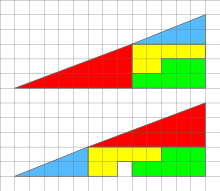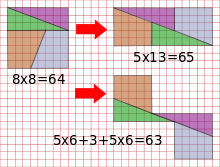Missing square puzzle
The missing-square puzzle is an optical illusion derived from geometry . It looks as if the area of a triangle varies in size, depending on how the individual areas are arranged. The riddle was probably invented in 1953 by the amateur magician Paul Curry in New York.
description
Two right triangles of equal size are compared with one another. The side lengths of 13 cm and 5 cm are known. (The unit of measurement itself is unimportant.) Both triangles consist of the same individual, here colored partial areas:
- a right triangle (here: blue) with an area of
- another triangle (here: red) with an area of
- two further areas (here: yellow and green), which together form a rectangle the size of which are yellow and green
The two total triangles look the same size and they consist of the same colored areas. Even so, there is still a square of the size left for the lower overall triangle . That seems strange, because the area of the whole shouldn't depend on how you put the individual areas together.
problem
The area of the two total triangles can easily be calculated because the cathetuses are known. These are the two side lines that start at right angles . The total area of a triangle total would therefore be: .
However, the results are different if you add up the individual partial areas of the two total triangles. In the case of the upper overall triangle, these are the four colored areas (red, blue, green and yellow). The sum is:
In the case of the lower overall triangle, however, the sum is different. Because in addition to the four colored areas, there is also the one square centimeter of the missing square. The total is then 33 cm². The total upper triangle is half a square centimeter missing, the total lower triangle is half a square centimeter. This is the mathematical proof that something cannot be right.
solution
The viewer is optically deceived: The overall structure is not triangles, but actually squares . The trick is that the red and blue triangles are only seemingly similar in a geometric sense. Their angles are actually different. Mathematically this can be proven as follows:
- blue triangle:
- red triangle:
- to compare the angles of a triangle with legs 13 and 5 in length (i.e. corresponding to the total triangle):
The two total triangles therefore do not have three, but four corners; however, one corner of this is barely visible. But it is still at the transition from the red to the blue triangle. The upper edges of the red and blue triangles appear in the alleged overall triangle as a long straight line, as a hypotenuse of the alleged overall triangle. In reality, the seemingly long straight has a kink, which is the fourth corner.
The apparent upper overall triangle is a concave (indented) quadrangle , and the apparent lower overall triangle is a convex (bent up) quadrangle. The areas of these two squares differ by 1 cm². This corresponds to the missing square.
It is an optical illusion in that the upper edge only appears to be a straight line. The eye suspects a triangle in the overall structure and is therefore inclined to overlook the kink. It is based on a uniform overall gradient.
You can also make a paper version of this optical illusion. The kink is covered by a thick border line. In addition, the cutting and stitching is too imprecise to tell the difference.
Similar puzzles
A special geometric arrangement by Sam Loyd illustrates an expanded paradox . It seems that the same geometric parts in different arrangements could occupy three different total areas. In reality, however, the parts do not touch each other completely and some of them also protrude beyond the checkered borders. The different total areas can be achieved through this waste .
literature
- Martin Gardner: Mathematics, Magic and Mystery . Courier (Dover), 1956, ISBN 9780486203355 , pp. 129-155
Web links
- Jigsaw paradox
- Eric W. Weisstein : Triangle Dissection Paradox . In: MathWorld (English).
- Curry's Paradox: How Is It Possible? (English)
- Triangles and Paradoxes (English)














